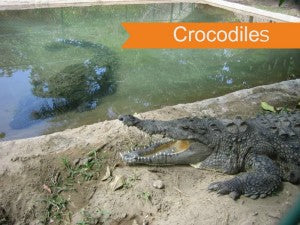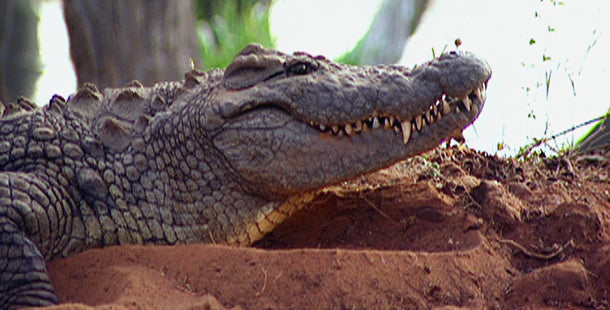Crocodile Rips Off Another Crocs Arm During Feeding

Photo Courtesy of San Diego Zoo
Two of nature's most skillful predators are the alligator and crocodile. Why? Crocodiles and alligators will eat just about anything if given the chance, and they have all the predatory characteristics needed to make it happen. These intelligent, cold-blooded creatures wait underwater for prey to get close enough before they lurch into a surprise attack. Although they are both dangerous, crocodiles and alligators are not the same. They differ in appearance, habitat, and aggressiveness, which is important to understand if you're ever attacked by or encounter one in the wild.
What You Need to Know About Crocodiles and Alligators
According to the San Diego Zoo, there are about 23 species of crocodilians (the scientific order to which alligators and crocodiles belong) each with distinct characteristics. As crocodilians, alligators and crocodiles have a variety of similar and different characteristics.


Photos Courtesy of Diffen.com

What to Watch Out For
Crocodiles and alligators are extremely similar when it comes to their senses. All crocodilians have an amazing sense of smell, sight, and hearing, making them excellent predators. According to the San Diego Zoo, they even have special sense organs (Dermal Pressure Receptors) embedded throughout their skin. These sensors act as motion detectors to help crocs find prey in muddy water, where crocs happen to be most comfortable. Since they are most comfortable near the water, make sure to take extra caution if you plan to travel near saltwater or freshwater habitats in warm climate zones. Often, crocodilians camouflage themselves in the water, holding their breath for over an hour, and appearing to be nothing more than floating logs. It's important to stay alert in these areas because it's easier to avoid a croc altogether than to escape one. If you see a croc, whether lounging in the sun on land or floating just beneath the surface of the water, get away. Crocodilians can typically swim up to 20 mph, making it extremely dangerous for you to be in the water with them. The San Diego Zoo even states they "[move] with ease by using their powerful, oar-like tails and strongly webbed hind feet." On land, crocs are a bit slower than in the water, but can still run for short distances up to 11 mph. When a croc does catch its prey, it will swallow it whole, unlike other carnivores who chew their food. If the prey is too large to swallow whole, the croc will tear off large pieces to eat. Once they have their prey in their jaws, they toss the food around to position it so it can easily slide down their throats when they tip their heads back. If a croc latches onto you for a meal, it's pretty difficult to get away. Depending on the species, crocodilian bites can generate up to 5,000 pounds of pressure per square inch (a humans bite is only about 100 pounds). All of this pressure is what allows a croc to easily bite through clothes, bones, and just about anything else.
How to Prevent an Attack
The best way to stay safe in crocodilian territory, which spreads across the southeastern United States and to the coastal areas of south Florida, is to avoid it altogether. However, if you do find yourself near infested waters, follow these tips from PBS.org to keep yourself safe and to prevent an attack.

Photo Courtesy of PBS.org
Alligators and Crocodiles:
- Never, ever feed a crocodilian. Feeding an alligator or crocodile helps them lose their fear of people.
- Stay alert, especially at key feeding times near dawn and dusk.
- Don't swim or wade in crocodilian infested water, if possible. If you have to, be sure to scan the water carefully for lurking predators that may look like floating logs.
- Don't clean fish or feed ducks in croc habitats.
- Keep small children and pets away from the water's edge. Alligators and crocodiles typically eat small prey, and nearly half of all known human fatalities were of children under the age of 12.
- When boating, don't dangle arms or legs in the water.
- Stay at least 35 feet away from a gator or croc lounging on land. Although they rarely attack on land, they can move quickly—and you don't want to stick around to see if they can actually catch you.
- Don't disturb babies or nests (which look like big mounds). Mother crocs guard their nests closely.
How to Survive an Attack
Despite making an effort to stay safe, if you travel near a crocodilian habitat, there is always a risk that you may get attacked. So what do you do if you find your arm or leg wedged between the sharp, crushing jaws of an alligator or crocodile? As large as adult humans are, crocodilians (especially adults) are larger. A croc will most likely try to drag an adult human into the water to tear off pieces of flesh to swallow. The most common way a croc does this is by performing the "death roll" while clamped on to an appendage. With its jaw securely locked around a piece of its prey, a croc will use a burst of energy to roll until the limb it holds is ripped off. The death roll is a very dangerous maneuver and can lead to serious injury, limb loss, and death. If a crocodilian latches onto you, the first thing you need to do is fight back aggressively before it can begin a death roll. Unfortunately, a croc's jaw has so much power that once it's locked, no amount of struggling will get it back open. Trying to pry a croc's mouth open with your hands won't work. Their armor-like skin is near impenetrable—no amount of kicking, punching, or other fighting can pierce it—and their heads are solid masses of bone. According to Chris Packham, wildlife presenter and crocodile fan, "there are no weak points" across their bodies So what do you do? 1. Gouge the Eyes! According to a variety of experts, the only way you can fight back is by gouging a croc's eye. Bob Cooper, an Australian bush craft expert and survival skills instructor, agreed that "poking the eyes is the only possible way you can fight back – [crocs] have thousands of years of instinct telling them this is the only vulnerable part of their body and they need to let go." 2. Note: If a good eye-gouging isn't possible, you can try attacking a croc's nostrils, ears, or palatal valve. 3. Attack the Palatal Valve. The palatal valve is a flap of skin that closes over a crocs throat, allowing them to submerge underwater without drowning—even when their mouths are open. If a croc is pulling you into the water with an appendage already in its mouth, you may be able to push the valve down, letting water flow into the crocs throat. You can try drowning the croc this way or repeatedly striking the valve to get the croc to let go (and then you run!). If your efforts haven't worked and a croc begins a death roll, you should: 1. Roll with the Croc. If you see a croc prepping to do the death roll, roll with it in the same direction to avoid causing extensive damage or limb loss. Death rolls use up a lot of energy, so a croc will need to rest before trying again. Once the death roll has been performed, use the time immediately after to fight the croc once more, going for the eyes, ears, nostrils, or palatal valve. Really, though, "the only way you can guarantee survival is [to] not get attacked in the first place," said Packham. After all, no amount of fighting tactics can promise you complete safety if you're attacked. There is always a risk in crocodilian country. Have you ever been attacked by a croc or other wildlife? Share your experience with us in the comments. Check out these articles to learn how to avoid (and survive) other types of wildlife attacks:
- "The Bear Necessities: Resources for Surviving a Bear Attack"
Sources: http://www.wikihow.com/Survive-an-Encounter-with-a-Crocodile-or-Alligator http://animals.sandiegozoo.org/animals/crocodilian http://www.pbs.org/wnet/nature/episodes/the-reptiles-alligators-and-crocodiles/living-with-alligators/2817/ http://www.diffen.com/difference/Alligator_vs_Crocodile http://www.livescience.com/32144-whats-the-difference-between-alligators-and-crocodiles.html http://www.discovery.com/tv-shows/mythbusters/mythbusters-database/zigzag-crocodile-run.htm http://www.theguardian.com/environment/2011/feb/14/surviving-crocodile-attack http://www.bbc.com/news/magazine-12448009 http://www.nps.gov/ever/naturescience/crocodile.htm
feganwhistless1947.blogspot.com
Source: https://beprepared.com/blogs/articles/what-to-do-if-you-get-caught-by-a-gator-or-croc
0 Response to "Crocodile Rips Off Another Crocs Arm During Feeding"
Postar um comentário